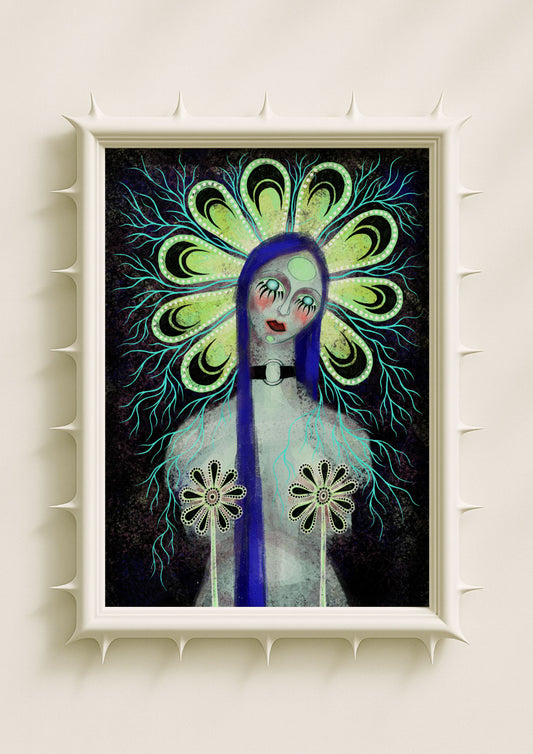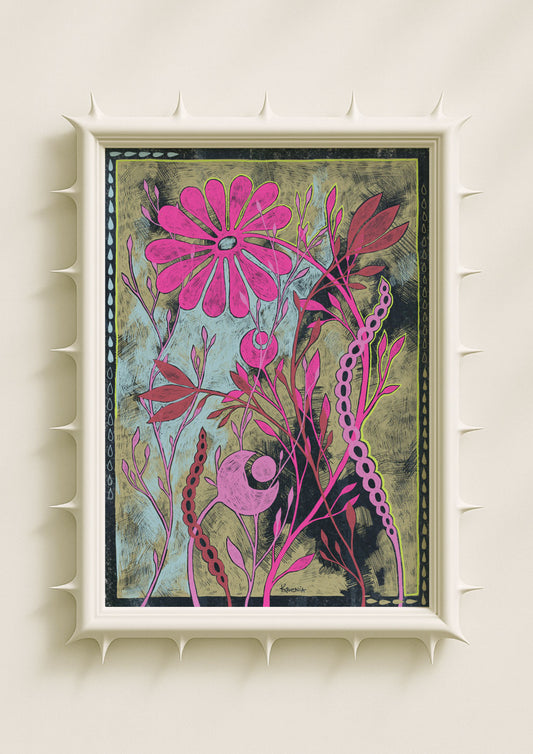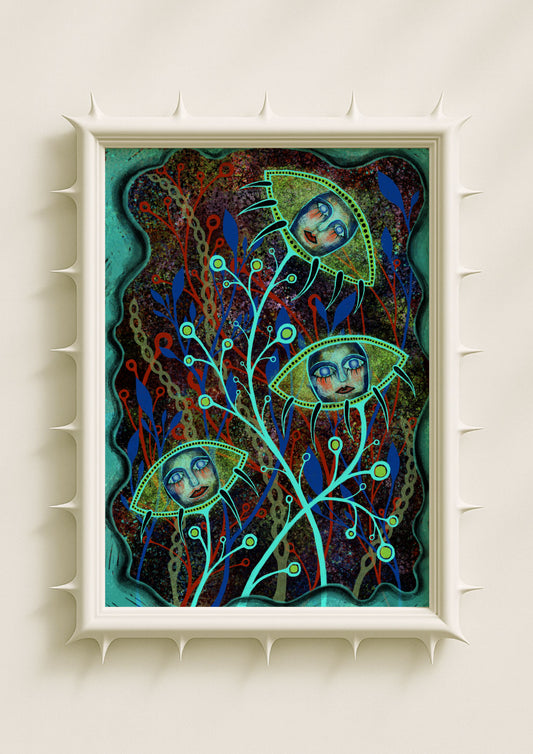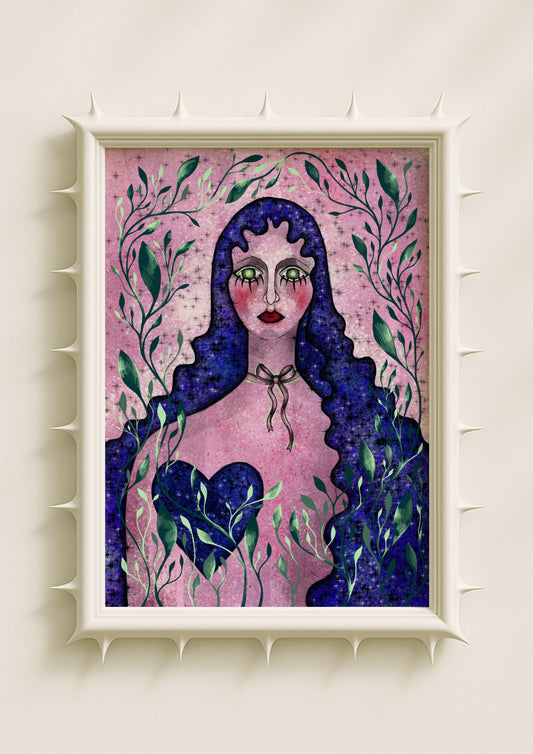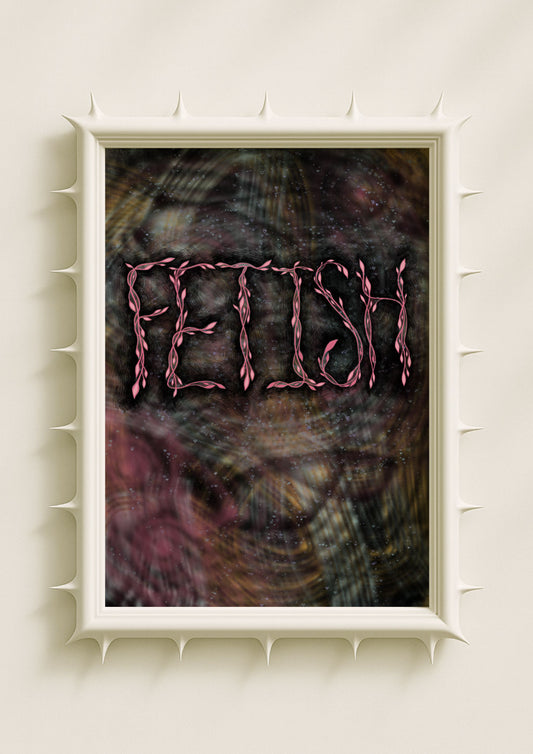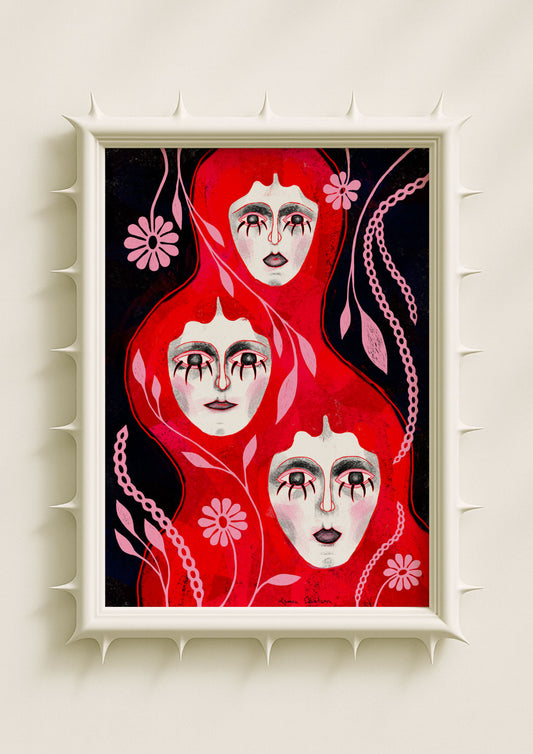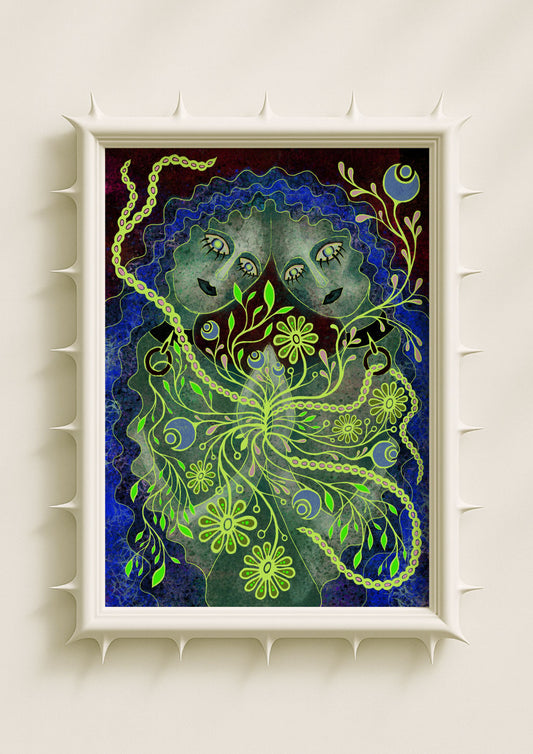A Surrealism Rooted in Emotion, Not Escape
Surrealism often gets described as dreamlike, strange, or detached from reality. But when filtered through a female gaze, surrealism becomes something else entirely — not an escape from emotion, but a way to articulate it. In my surreal portrait posters, the distortions, botanical currents and layered faces aren’t meant to shock. They’re meant to open the psychological space that realism sometimes closes. They give women’s inner worlds room to unfold without being compressed into familiar narratives or visual clichés.
Botanicals as Emotional Extensions
The flowers and vines in my portraits aren’t decoration; they’re emotional signals. They move like thoughts, they blur like memories, they bloom like feelings that refuse to stay still. Through the female gaze, botanicals stop being symbols of beauty imposed on women. Instead, they interact with the figure, growing out of her, protecting her, shadowing her, echoing her state of mind. A petal that curves too far, a vine that wraps around the jawline, an impossible bloom pressed against the cheek — these details externalise the inner dialogue. They visualise softness, tension, desire and reflection in ways a literal portrait cannot.

Fragmented Faces and the Complexity of Identity
Fragmented faces appear often in my prints: mirrored profiles, doubled features, a single face split into layers. This fragmentation isn’t about distortion — it’s about truth. Women rarely experience themselves as one singular identity. They move between roles, moods and versions of themselves constantly. The female gaze recognises this multiplicity instead of tidying it away. Through surreal portraiture, I can show the shifting self: the woman who feels tender and guarded at the same time, the version who wants closeness and the one who fears it, the emotional echo of who she was yesterday and who she is now.
Dreamlike Detailing as Emotional Atmosphere
My surreal portraits often feel as if they belong to a dream — not because they are unreal, but because dreams are where emotion speaks without filters. Heavy outlines around pale skin, exaggerated eyes, floating shapes, shadows that move like water — these elements create a visual language that leans into intuition. The female gaze thrives in this atmosphere because it allows emotional truth to rise gently, without needing to be explained or justified. The dreamlike quality becomes a protective layer, a soft veil through which deeper meaning can seep.

Escaping Stereotypes by Refusing Literalism
Traditional depictions of women often rely on literal gestures: a smile to signify beauty, a pose to signal vulnerability, a costume to announce femininity. Surrealism lets me resist all of that. A woman’s emotional world can be shown without placing her into a trope. A fragmented face communicates complexity better than a perfect one. A botanical shadow says more about fragility than a staged expression. A surreal contour can hold more truth than a realistic portrait ever could. The female gaze avoids spectacle because it refuses to flatten. It seeks nuance, not performance.
Symbolism as Emotional Language
Every symbolic element in my portraits — from the oversized eyes to the distorted petals — works like a piece of emotional shorthand. They never function as riddles. They function as feelings. Eyes become mirrors. Flowers become breath. Shadows become memory. When a woman is drawn through symbolism rather than literal realism, her inner world becomes visible without being pinned down. This is the most powerful aspect of the female gaze: it represents women not through what they show, but through what they feel.
Surreal Portrait Posters in Contemporary Interiors
In a room, a surreal portrait shaped by the female gaze has a very specific presence. It doesn’t dominate or decorate — it sensitises the atmosphere. It adds emotional depth to clean spaces, softness to rigid ones, complexity to minimalist interiors. Homes often need this kind of quiet psychological layering: something that isn’t loud, but lingers. Surreal wall art brings a mood that feels alive, a whisper of inner worlds moving beneath the surface.

Looking Inward Instead of Putting on a Show
Ultimately, surreal portrait posters seen through a female gaze shift the focus from the exterior to the interior. They reject spectacle in favour of symbolism. They show emotional reality instead of flattened stereotype. They honour the strangeness, softness and multiplicity that shape women’s lives. And on a wall — in the stillness of a room — they offer a place where complexity is allowed to exist without explanation, like a quiet dream that stays with you long after you’ve woken.
